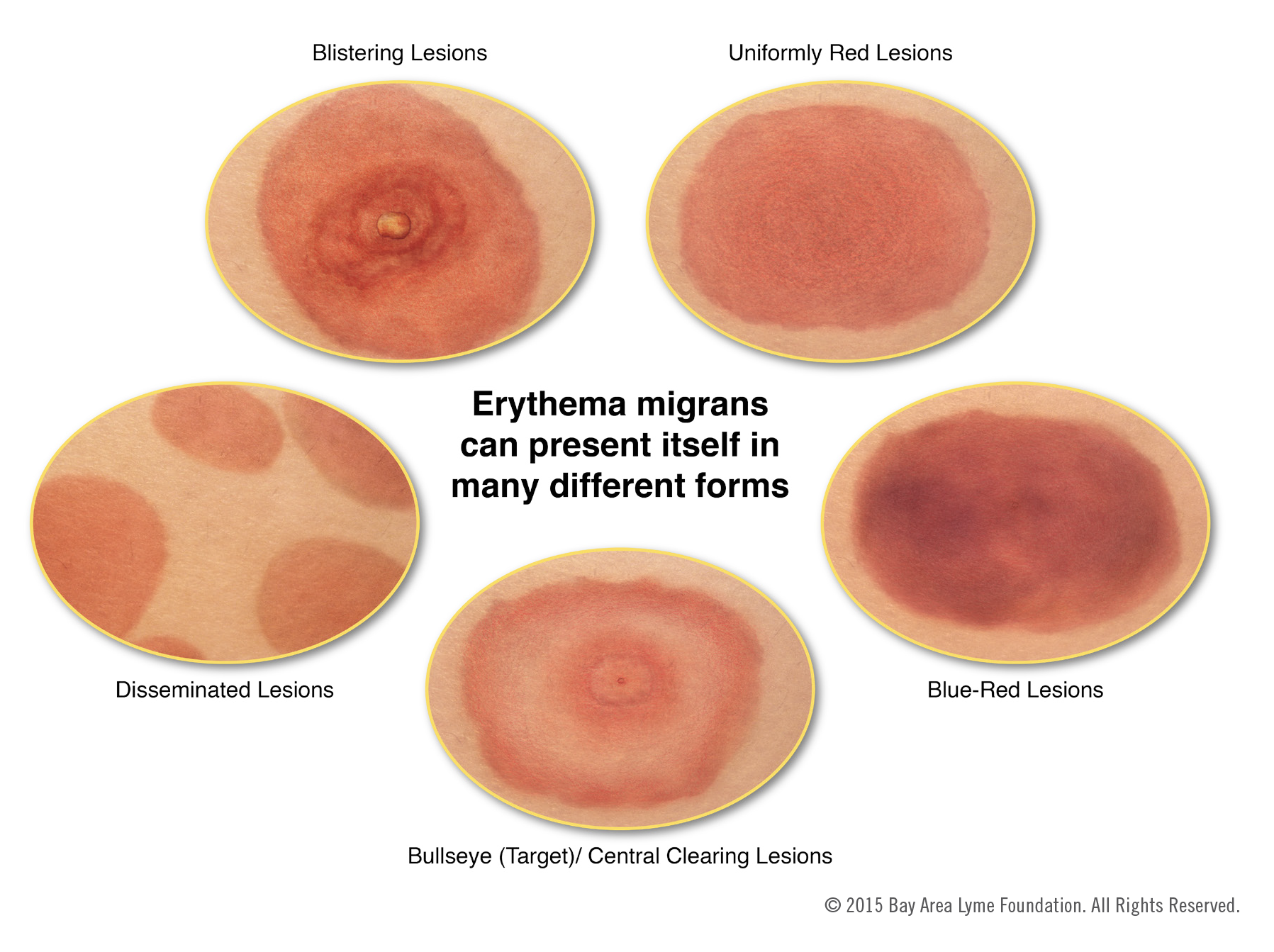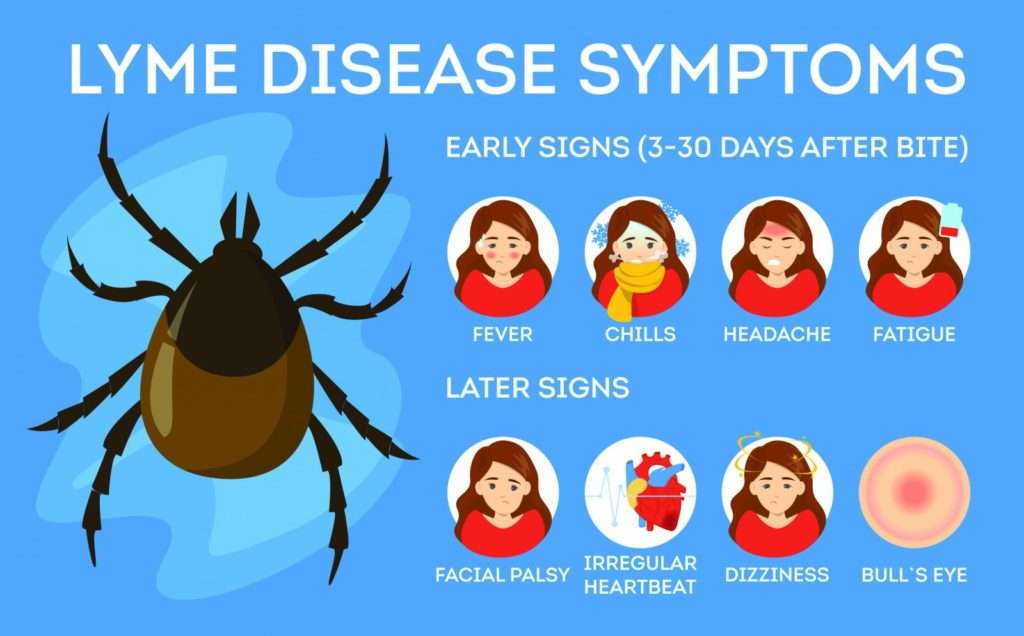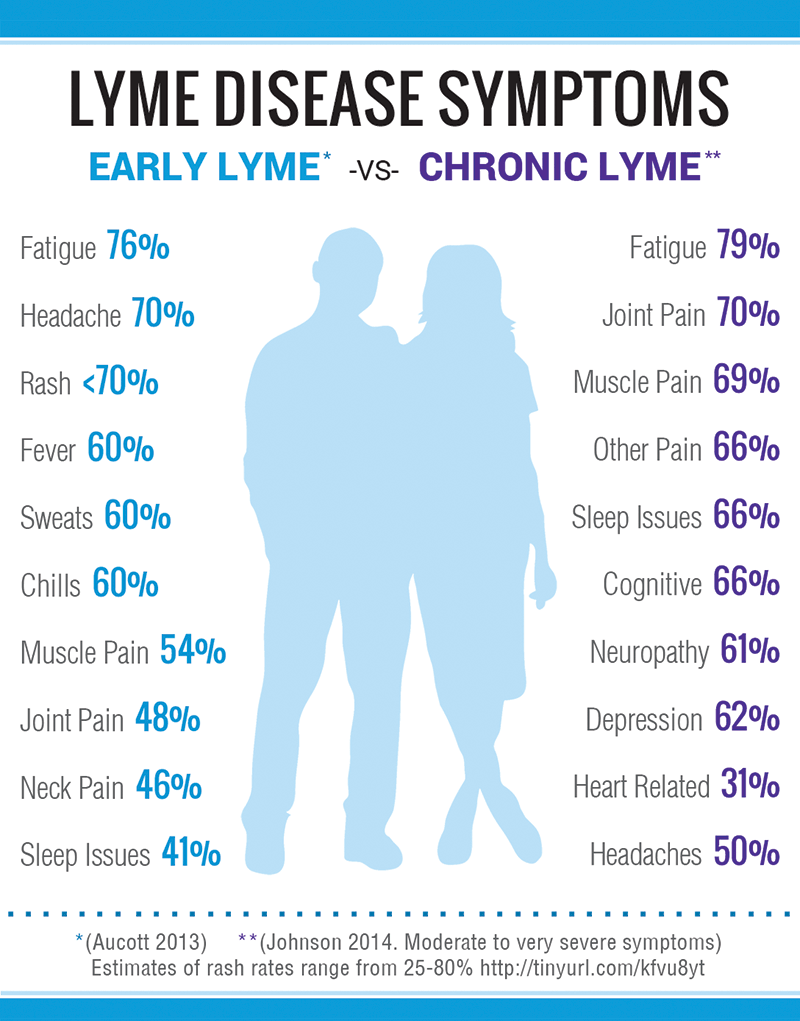Lyme Disease Symptoms: Common Signs Rare Signs And Misconceptions
Home » Tick Talk » Lyme Disease Symptoms: Common Signs, Rare Signs and Misconceptions
Lyme disease, the most common vector-borne disease in the United States, can cause a variety of non-specific symptoms that can make it tricky to diagnose especially as the infection progresses. In the following article, learn the most and least common Lyme disease symptoms, how the disease can change over time, and more.
Stage : Small Oval Rashes Or A Reddish Lump
When a tick that causes Lyme disease bites you, it infects you with bacteria. Without treatment, the bacteria can spread to other areas of your body. Stage 2 begins when the bacteria spread to other parts of your body.
During this stage, you may see small, oval rashes on your skin. Some people develop a bluish-red lump.
Where you see these signs: Because the infection has spread, small rashes can appear anywhere on your skin, except for your palms and soles. Most rashes appear on the arms, legs, and face.
Some people develop a lump, which your doctor may refer to as borrelial lymphocytoma. In children, this lump tends to appear on an earlobe. Adults often see a raised growth form around a nipple.
Borrelial lymphocytoma on a childs ear
This can appear in stage 2 of Lyme disease.
What you may see on your skin: The rashes that appear during stage 2 differ from the rash that can appear in stage 1. In stage 2, the rashes stay the same size rather than grow larger.
When the rashes, lump, and symptoms begin: About 30 to 45 days after the tick bites you, you may notice rashes or a lump. These can also take longer to appear, sometimes six months or more.
Some people develop symptoms, which make them feel ill, including:
-
Fever
-
Shortness of breath and dizzy spells
-
Bells palsy, which causes one half of the face to droop
-
Heart problems, such as chest pains or an irregular heartbeat
Can Lyme Disease Cause Walking Problems
As mentioned above, Lyme disease can cause issues with balance, which will lead to problems with walking. The inner ear maintains balance so that we can move around without feeling dizzy or disconnected from our footing. Walking problems can also arise for a person with the condition because of the way it affects the joints. Although the pain tends to be intermittent in the affected joints, it can hinder a persons ability to walk as they used to. This symptom of Lyme disease is referred to as Lyme arthritis.
Don’t Miss: Long Term Antibiotic Use For Lyme Disease
Will Tinnitus Caused By Lyme Disease Go Away After Treatment
The answer is yes and no. In some cases, Tinnitus resolves after Lyme disease is resolved. In many cases, it can permanently persist if the damage to the auditory nerve is permanent. Tinnitus is usually permanent if the patient has also suffered partial or full hearing loss. It is also more likely to be permanent or chronic if Lyme disease wasnt treated in the first few weeks after it was contracted.
Many symptoms of Lyme disease including Tinnitus can continue to persist even up to 6 months after successful treatment. This is a phenomenon that is called Post-Treatment Lyme Disease Syndrome .
Tinnitus and You is a Tinnitus information blog with advice on treatment, management, identification of causes and latest news on Tinnitus.
How Is Lyme Disease Diagnosed

Your doctor will diagnose you based on your symptoms and whether youâve been exposed to a tick. They might also run a blood test. In the first few weeks of infection, the test may be negative because antibodies take a few weeks to show up.
Hopefully soon, there will be tests that can diagnose Lyme disease in the first few weeks after youâre exposed. The earlier you get treated, the less likely itâll get worse.
Also Check: Antibiotics Used For Lyme Disease
Can Lyme Disease Mask Leukemia
Since the typical symptoms of leukemia and Lyme disease are different, it is unlikely that Lyme disease could mask leukemia.
Some people with leukemia develop a rash on their skin. This happens because of blood vessels that burst under the skin. A person with a leukemia rash may be concerned that the rash is a sign they have Lyme disease. But the rash that can sometimes happen with Lyme disease can be a distinctive bulls-eye rash. A rash is present in around
contains some useful information about how to help prevent tick bites.
For example, although ticks are present all year round, they are at their most active during warmer months. In the United States, this means they are most active between April and September.
Ticks also prefer grassy or wooded areas. By limiting exposure to these environments at those times, a person can lower their chances of getting a tick bite.
People can also treat any outdoor gear or clothing with products that contain 0.5% permethrin, and by using EPA-registered insect repellents. Regularly checking clothing and exposed body parts while outdoors can help locate ticks before they bite.
Covering the body with long-sleeved or long-legged clothing can also protect the skin from tick bites.
When Should I Call The Doctor
If a tick bites you, call your doctor. Other conditions can cause similar symptoms, so it’s always a good idea to discuss them with your doctor. That way you can get checked and treated, if needed. Call right away if you get a red-ringed rash, lasting flu-like symptoms, joint pain or a swollen joint, or facial paralysis.
You May Like: How Long Does It Take To Get Lyme Disease
Gastrointestinal Symptoms Of Lyme Disease
The spirochete that causes Lyme disease Borrelia burgdorferi and the associated tickborne infections such as Bartonella and Babesia can directly affect any organ system in the body, including the gastrointestinal tract. About 80% of the immune system is located around the digestive tract, so digestive health influences the immune response. Gastrointestinal symptoms of Lyme disease range from food intolerances to constipation.
Rarely does acute Lyme disease cause gastrointestinal symptoms, but occasionally nausea, vomiting, heartburn, and abdominal pain can occur. More commonly, digestive symptoms such as constipation, gas/bloating, and abdominal discomfort occur in chronic or late-stage Lyme disease. Lyme bacteria can directly infect the gastrointestinal tract causing inflammation that creates digestive symptoms. In turn, digestive issues can cause immune dysregulation increasing susceptibility to chronic infections. Whether digestive problems are a result of Lyme disease or increase the susceptibility to chronic infections, it is essential to address the underlying issues to restore health more quickly and effectively.
How To Prevent Lyme Disease
There is currently no vaccine for Lyme disease, so it’s important to take steps to prevent being bitten by ticks, particularly when you’re out in the countryside:
Wear trousers tucked into boots and long sleeve clothing when out walking or hiking. Use insect repellents every time, ideally one with 10 per cent DEET. Always check for ticks including children and pets when you get home. Remove ticks very carefully, pulling steadily using tweezers or a cotton thread.
: 23-06-2021
Also Check: Can Lyme Disease Make Your Liver Enzymes Off
What Should I Do If I Am Bitten By A Tick
If you experience a tick bite, the best way to remove it is by taking the following steps:
- Tug gently but firmly with blunt tweezers near the “head” of the tick at the level of your skin until it releases its hold on the skin.
- Avoid crushing the tick’s body or handling the tick with bare fingers as you could exposure yourself to the bacteria in the tick.
- Wash the bite area thoroughly with soap and water.
- DO NOT use kerosene, petroleum jelly , or hot cigarette butts to remove the tick.
- DO NOT squeeze the tick’s body with your fingers or tweezers.
How Is Tinnitus Caused By Lyme Disease Diagnosed
Lyme disease in itself is a hard disease to diagnose. This is because its symptoms mimic other diseases and disorders like multiple sclerosis, rheumatoid arthritis, fibromyalgia, lupus and some autoimmune diseases.
But, if you have already been diagnosed for Lyme disease, your Tinnitus caused by Lyme disease might be confirmed with a Auditory Brainstem Response test. Other tests that may be used to confirm your Tinnitus diagnosis could be imaging studies, ear inspections or even a thorough investigation into the history of your Lyme disease and Tinnitus.
Recommended Reading: Herbs That Kill Lyme Disease
Testing For Lyme Disease In Dogs
Lyme disease spread by ticks can be diagnosed with a simple blood tests in your veterinarian’s clinic. The C6 test is very sensitive and specific at diagnosing cases of Lyme disease and depending on clinical signs and concurrent results, treatment may be started immediately. If treatment has been successful, reductions in the QC6 at six months should be lower than the starting point.
Diagnosing Lyme Disease And Ms

Some of the effects of Lyme disease and MS can be seen in imaging tests. Lyme disease may sometimes lead to abnormalities similar to those seen in people with MS on MRI brain scans and analysis of the cerebrospinal fluid.
If you are unsure about your symptoms, see a neurologist who is specially trained to know the differences between MS and Lyme disease. Neurology experts will be able to perform tests used to diagnose the two conditions, such as:
- Blood tests
- MRI scan
- Lumbar puncture
- Enzyme-linked immunosorbent assay test, or a Western blot test, which checks for the presence of antibodies to B. burgdorferi
Read Also: What Antibiotics Cure Lyme Disease
Lyme Disease Symptoms To Watch For According To Doctors
Knowing the symptoms to look for can help diagnose Lyme disease early on, when it’s easily treatable.
Fever or fatigue, with or without a rash, can be a symptom of many thingsand Lyme disease is just one possibility. To diagnose Lyme, doctors say they have to consider symptoms and circumstances. If youve been hanging out in wooded or grassy areas, especially in certain regions of the country during the spring, summer, or even autumn months, it might make sense to entertain the possibility that you were bitten by a tick. And whats the most commonly reported tick-borne illness in America? Its Lyme disease, by far.
But Timothy P. Flanagan, MD, associate professor of medicine in the infectious diseases division at Brown Universitys Alpert Medical School, says it would be a mistake to latch on to a Lyme diagnosis without ruling out other possible causes, including other infections transmitted by ticks. You could have a different tick-borne infection entirely, such as anaplasmosis or babesiosis, or you could have Lyme with one or more co-infections. Thats because the same ticks that transmit Borrelia can carry other disease-causing microbes, too.
Its super important that we think of all the tick-borne diseasesnot just Lyme, Dr. Flanagan tells Health. Babesia, a parasite that causes babesiosis, is treated differently than Borrelia, for example.
What Are The Symptoms Of Lyme Disease
Symptoms of Lyme disease can be different from person to person.
Early signs and symptoms of Lyme disease usually start 3 to 30 days after you have been bitten by an infected blacklegged tick. Most people experience mild flu-like symptoms soon after being bitten, while a small number may have more serious symptoms, sometimes weeks after the bite.
Early signs and symptoms of Lyme disease may include:
- Rash, sometimes shaped like a bull’s eye )
- Fever
- Muscle and joint aches
- Swollen lymph nodes
If left untreated, more severe symptoms may occur and can last from months to years. Severe symptoms may include:
- Severe headaches
- Facial paralysis
- Intermittent muscle, joint, tendon and bone aches
- Heart disorders , known as Lyme carditis
- Neurological disorders
- Arthritis with severe joint pain and swelling, particularly the knees and less commonly in other joints such as the ankle, elbow and wrists.
In rare cases, Lyme disease can lead to death usually because of complications involving infection of the heart.
You May Like: What To Do If I Have Lyme Disease
What Are The Neurological Symptoms Of Lyme Disease
In some cases, the neurological symptoms of Lyme disease can be specific in nature. However, other times they are subtle to the point of being insufficient for a Lyme diagnosis. Those with the condition can end up experiencing symptoms of cognitive decline, such as difficulty concentrating or the inability to process information at the rate they did prior to the tick bite. Memory can also be affected by Lyme disease, and can lead to confusion. People may also experience an increased sensitivity to light and changes in their vision.
Because of the way Lyme disease affects cranial nerves and other parts of the brain, other neurological symptoms may appear. The cranial nerve thats affected will determine the type of symptom that occurs. For example, if the facial nerve is affected, a person may experience facial weakness or paralysis. Other nerves being affected can lead to symptoms such as dizziness, balance issues, loss of coordination, and a loss of taste or smell. In more severe cases, people can develop conditions that cause inflammation of the area where the brain and spinal cord meet, leading to meningitis or encephalopathy.
What Happens At Your Appointment
The GP will ask about your symptoms and consider any rash or recent tick bites you know about.
Lyme disease can be difficult to diagnose. It has similar symptoms to other conditions and there’s not always an obvious rash.
2 types of blood test are available to help confirm or rule out Lyme disease. But these tests are not always accurate in the early stages of the disease.
You may need to be retested if you still have Lyme disease symptoms after a negative result.
Don’t Miss: Can Lyme Disease Cause Rheumatoid Arthritis
What Are The Signs & Symptoms Of Lyme Disease
Lyme disease can affect different body systems, such as the nervous system, joints, skin, and heart. The symptoms of Lyme disease are often described as happening in three stages. Not everyone with Lyme has all of these, though:
The rash sometimes has a “bull’s-eye” appearance, with a central red spot surrounded by clear skin that is ringed by an expanding red rash. It also can appear as an growing ring of solid redness. It’s usually flat and painless, but sometimes can be warm to the touch, itchy, scaly, burning, or prickling. The rash may look and feel very different from one person to the next. It can be harder to see on people with darker skin tones, where it can look like a bruise. It gets bigger for a few days to weeks, then goes away on its own. A person also may have flu-like symptoms such as fever, tiredness, headache, and muscle aches.
Chronic Lyme Dos And Don’ts
Chronic Lyme disease is an ongoing Borrelia burgdorferi infection that can involve any body system or tissue. The infection produces a wide range of symptoms and signs, which can be debilitating for some patients. Common symptoms include severe fatigue, migratory musculoskeletal pain, headaches, and impaired memory. Unfortunately, chronic Lyme disease is complex and often misunderstood, which means that many patients will struggle to obtain the care they need to regain their health. Every patient concerned about Lyme disease and tick-borne illness should know the following.
Read Also: Lyme Disease Ever Go Away
Sensitivities To Light And Sound
One of the pioneers in Lyme disease research is Joseph J. Burrascano Jr., MD. In the early days of the disease, he came up with a checklist that doctors could use to diagnose itand it includes all of the above signs, as well as other previously observed symptoms like sensitivities to light and sound, muscle weakness, erectile dysfunction, and dental pain.
The Numbers On Chronic Lyme

Because Lyme disease is commonly missed or misdiagnosed, statistics vary on how many Lyme patients go on to experience chronic symptoms. The following research nonetheless paints a basic picture of the problem.
- An estimated 5-20% of patients may have chronic symptoms after getting Lyme disease, according to the Columbia University Irving Medical Center.
- The treatment failure rate for chronic Lyme disease patients was estimated at 26-50% in 2004, compared to 16-39% for early Lyme patients, according to Lymedisease.org.
- Up to 15-40% of late-stage Lyme patients develop neurological disorders, which are responsible for many common symptoms of chronic Lyme disease.
Experts dont know for sure why some people experience persistent symptoms, even with treatment. However, some believe the Lyme infection may trigger an auto-immune response that manifests in the chronic symptoms detailed below.
You May Like: Best Infrared Sauna For Lyme Disease
What Are The Second Stage Signs And Symptoms Of Lyme Disease
The symptoms of second stage, early disseminated, Lyme disease can be difficult to attribute. Symptoms include severe fatigue, fever, pain, intermittent weakness and achiness of the muscles and joints, numbness in arms and legs, vision changes, and cognitive dysfunction such as short-term memory difficulties and problems multitasking. These symptoms are not specific for Lyme disease and can make the diagnosis of second stage Lyme disease very challenging.
More recognizable Lyme disease nervous system manifestations include facial paralysis , or meningitis with severe headache and stiff neck. Notable cardiac manifestations include passing out or feeling faint from an abnormally slow heart rate, irregular heart palpitations, or unexplained difficulty tolerating exercise. Meningitis and carditis are both potentially serious Lyme disease conditions and warrant immediate medical attention.